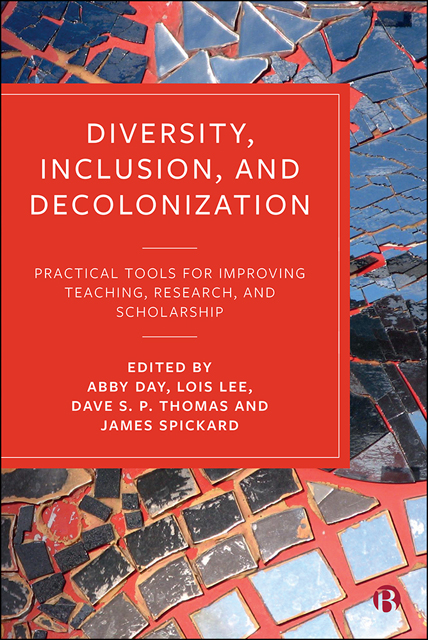 Diversity, Inclusion, and Decolonization
Diversity, Inclusion, and Decolonization Book contents
- Frontmatter
- Contents
- List of Figures and Tables
- Notes on Contributors
- Acknowledgements
- Typographical Note
- Introduction: Why Diversity, Inclusion, and Decolonization Matter
- Part I Changing Universities
- Part II Diversifying Curricula
- Part III Diversifying Research and Scholarship
- Part IV Overcoming Intellectual Colonialism
- Epilogue: What We Have Learned
- Index
1 - Negotiating Diversity, a Personal Reflection
Published online by Cambridge University Press: 13 October 2022
- Frontmatter
- Contents
- List of Figures and Tables
- Notes on Contributors
- Acknowledgements
- Typographical Note
- Introduction: Why Diversity, Inclusion, and Decolonization Matter
- Part I Changing Universities
- Part II Diversifying Curricula
- Part III Diversifying Research and Scholarship
- Part IV Overcoming Intellectual Colonialism
- Epilogue: What We Have Learned
- Index
Summary
Introduction
One of my first jobs in higher education was as a part-time tutor in the Department of Anthropology at the University of Manchester in 1987. Just over 30 years later I am now Pro-Vice Chancellor for Education at Swansea University. Much of the time in between, 23 years, was spent at the University of Birmingham. When Theresa Ogbekhiulu, the full-time Officer for Education at our Students’ Union asked me, just a few days ago, what was the thing I was most proud of in my time working in higher education, I replied, very quickly, that it was to see so many students, and so many colleagues, grow, develop and achieve more than they thought possible. Theresa, herself, is a clear example of that, from arriving in her role two years ago, a shy international student from Nigeria, who had begun her career at Swansea on our access programme, to becoming a confident activist who is drawing on all her own experiences to transform the responses, not just of Swansea University but also of the higher education sector across Wales, to race and racial discrimination.
In this chapter I want to use some of my own experience, and the attempts I have made over the years to support others, to give a very personal perspective on the development of equality, diversity and inclusion in British higher education from the 1980s to the current day. I would not describe myself as an ‘activist’, far from it, but I have always been passionate about diversity and the need to celebrate diversity within education. I want to ponder on a number of examples from my own experience to try to understand the range of possible approaches to what might be called ‘activism’ around equality, diversity and inclusion within higher education, whether that relates to sexuality, gender, faith, race or disability.
1980s radicalism
As an undergraduate I was closely involved with the chaplaincy at Manchester University, but this was never the limit of my engagement, either with faithbased groups or in terms of my own ‘activism’.
Information
- Type
- Chapter
- Information
- Diversity, Inclusion, and DecolonizationPractical Tools for Improving Teaching, Research, and Scholarship, pp. 21 - 30Publisher: Bristol University PressPrint publication year: 2022